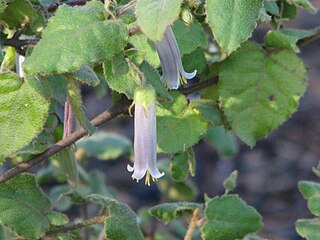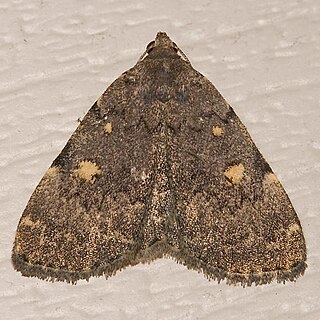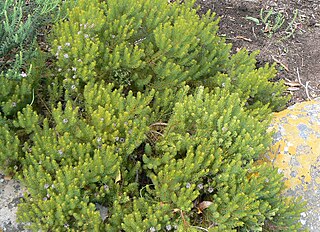
Aeranthes, abbreviated Aerth in the horticultural trade, is an orchid genus with 47 species, mostly from shady, tropical humid forests in Zimbabwe, Madagascar and islands in the Western Indian Ocean. The name "aeranthes" means 'aerial flower', because it grows high in the air.

Banksia aemula, commonly known as the wallum banksia, is a shrub of the family Proteaceae. Found from Bundaberg south to Sydney on the Australian east coast, it is encountered as a shrub or a tree to 8 m (26 ft) in coastal heath on deep sandy soil, known as Wallum. It has wrinkled orange bark and shiny green serrated leaves, with green-yellow flower spikes, known as inflorescences, appearing in autumn. The flower spikes turn grey as they age and large grey follicles appear. Banksia aemula resprouts from its woody base, known as a lignotuber, after bushfires.

Plusiinae is a smallish subfamily of the moth family Noctuidae. As the Noctuidae appear to be a paraphyletic assemblage, the Plusiinae may eventually be raised to family status.
Crataegus aemula, the Rome hawthorn, is a species of hawthorn that is common in some parts of Mississippi and Georgia, and also occurs in Alabama. It is a perennial shrub or tree. Its habitats include oak flatwoods and brush.

Scaevola aemula, commonly known as the fairy fan-flower or common fan-flower, is a species of flowering plant in the family Goodeniaceae. It has mostly egg-shaped leaves and blue, mauve or white fan-shaped flowers. It grows in New South Wales, South Australia and Victoria.
Diacrita aemula is a species of ulidiid or picture-winged fly in the genus Diacrita of the family Tephritidae.

Correa aemula, commonly known as the hairy correa, is a species of shrub that is endemic to south-eastern Australia. It has broadly heart-shaped leaves arranged in opposite pairs, green or greyish green, pendent flowers arranged singly or in pairs and ageing to mauve-purple.

Autographa aemula is a moth of the family Noctuidae. It is found in mountainous areas, more specifically in the Alps, Southern France, Northeast Turkey and the Caucasus.

Idia aemula, the common idia, powdered snout or waved tabby, is a litter moth of the family Erebidae. The species was first described by Jacob Hübner in 1813. It is found from Canada south to Florida and Texas. It has been reported in the Palearctic.

Serruria aemula is a critically endangered species of flowering plant in the family Proteaceae, endemic to South Africa. It is known by the common name of strawberry spiderhead.

Sabatinca aemula is a species of moth belonging to the family Micropterigidae. It is endemic to New Zealand and is found in the north western parts of the South Island. The larvae of this species has yet to be collected but it has been hypothesised that the larvae subsist on foliose liverworts similar to other species in the Sabatinca genus. The adults of the species are on the wing from the middle of September until the end of December. The adults of S. aemula are very similar in appearance to S. chrysargyra and it has been argued they can only be distinguished by dissection. However more recent research suggests that the colour patterns on the forewings of the two species can be sufficient to distinguish between the two species.
A Uniform Resource Locator (URL), colloquially known as an address on the Web, is a reference to a resource that specifies its location on a computer network and a mechanism for retrieving it. A URL is a specific type of Uniform Resource Identifier (URI), although many people use the two terms interchangeably. URLs occur most commonly to reference web pages (HTTP/HTTPS) but are also used for file transfer (FTP), email (mailto), database access (JDBC), and many other applications.
Aeranthes adenopoda is a species of orchid native to Madagascar. It was first described by H. Perrier in 1938. Its IUCN status is Not Evaluated.

Dryopteris aemula, the hay-scented buckler-fern or hay-scented fern, is a species of perennial leptosporangiate fern.

Eldridge Industries LLC is an American holding company headquartered in Greenwich, Connecticut, with offices in New York City, London, and Beverly Hills. Eldridge makes investments in various industries including insurance, asset management, technology, sports, media, real estate, and the consumer sector.
Timothy R. Bonner is an American attorney and politician, currently serving as a member of the Pennsylvania House of Representatives from the 17th district. Prior to redistricting, he served from the 8th district.










